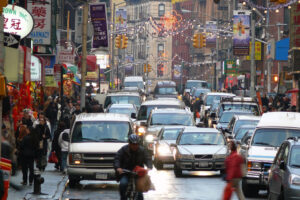Economics
Coordinated Conflict: A Property Rights Perspective on Traffic
Economic analysis as a way of thinking can be understood as both a science and an art. As a science, economic analysis takes as its analytical starting…


The “trade” of the economist as a social scientist is to understand the emergence of spontaneous order in terms of systematic generalizations of cause and effect, the cause being the purposes and plans human beings attach to their action, and the effect being a consequence of individuals attempting to realize their goals through action with the means available to them. The “world” of the economist, as James Buchanan puts it, is one of “coordinated conflict” ([1966] 1979, p. 118), but the art of understanding how conflicting goals become coordinated requires that economics as a science “must be preoccupied with meanings” (Storr 2013, p. 25).
One of the best examples to illustrate this notion of economics as a science of meanings, to understand how coordinated conflict emerges, is the observation of car traffic patterns. From a helicopter view, the tranquil beauty of the pattern itself appears as if car traffic had been designed by an individual, yet if one has ever driven in the New York City metropolitan area, it would appear that the situation on the ground is more akin to conflict rather than coordination. Indeed, as someone who had grown into adulthood in the New York City area, and having now lived a decade in the Washington, D.C. metropolitan area, I am too often told how angry, impatient, and most importantly for my point here, downright disrespectful drivers in and around New York City (NYC) can be, even from other native New Yorkers who now reside elsewhere. Indeed, my driving experience in the Washington, D.C. area is not filled with horns honking, tailgating, cursing, or other offensive hand gestures to which I had become accustomed in New York.
This being said, given the growing traffic and congestion that has marked the Washington, D.C. area, my experience living in both areas has given me a new perspective—one that has even surprised me—that has led me to conclude the very opposite.
When we understand the meaning and purposes attached to the actions of drivers around the NYC area, we realize that what appears to be anger and impatience directed to one driver is the act of paying great respect to other drivers by facilitating “coordinated conflict” as Buchanan refers to it. Simultaneously, I’ve come to conclude that drivers in the Washington, D.C. area are in fact acting very disrespectfully. My point here is not to imply that being impolite to other drivers is necessarily a good thing, nor that this phenomenon is unique to the NYC area. Anyone driving in, for example, Guatemala City or Palermo will see a similar phenomenon. Rather, it is to suggest that before we can pass any normative judgements regarding the means that individuals utilize to achieve their goals, we must first understand their goals as the individuals themselves perceive them and how they are conducive to facilitating the coordination of conflicting goals without command. As Virgil Storr states this point, “we cannot figure out the meaning of an action without some knowledge of the context and the actor’s motivations” (2013, p. 11).
As absurd as this conclusion may seem, the basis for this conclusion can be found in Harold Demsetz’s seminal paper, “Toward a Theory of Property Rights” (1967), in which Demsetz argues that “the main allocative function of property rights is the internalization of beneficial and harmful effects” (1967, p. 350). The fact that the roads in the NYC area and the Washington, D.C. area are neither privately owned nor priced (except where there is tolling by EZ-Pass, which arguably are not market prices), there are high transaction costs associated with internalizing the harmful effects of traffic, such as reducing the reliability of expectations regarding the time to travel from one distance to another.
Given the absence of formal definition in private property over roads, and therefore the ability to price and exchange the use of roads to individuals that value it at a particular time and place the most, we can conclude that if roads are public property, then no one owns the road in the appropriate sense of bearing the full costs and benefits of their decision-making. What economic analysis teaches us is that, in a world of positive transaction costs, non-price mechanisms of coordinating conflict emerge, including custom, habits, and norms to create reliable expectations regarding social interaction.
From a property rights standpoint, then, we can understand that the meaning attached to the actions of drivers in the NYC area, which an external observer perceives to be disrespectful, is actually an emergent culture, or pattern of meanings, that reduces the transaction costs associated with defining property rights over roads. Stated succinctly (and perhaps in a blunt NY tone?), since you don’t own the road, what right have you to hold up traffic by being indecisive when switching lanes, not moving immediately when the traffic light turns green, or driving slowly in the passing lane? Thus, drivers in the NYC are like all human beings are doing the best they can, given the circumstances they face, but the manner in which they are doing their best must be understood in terms of the meanings they attach to their actions.
- Michael Munger on Traffic. EconTalk.
- “Sell the Streets,” by Benjamin Powell. Econlib, May 4, 2009.
- A Conversation with Harold Demsetz. Intellectual Portrait Series. Intro by Amy Willis. Liberty Fund video.
- “Snow Jobs,” by Fred S. McChesney. Property rights after blizzards. Econlib, Oct. 15, 2001.
Perhaps, more importantly, traffic in the NYC area would be far worse if such attitudes and habits did not emerge, given the absence of private property in roads. The implication here is that private property is indeed the basis for catallaxy, or catallactic competition as Ludvig von Mises phrases it, and its absence prompts the emergence of other informal institutional arrangements to coordinate conflict. Therefore, if we are to understand how coordinated conflict emerges, we must first understand that economic is a science of meanings attached to human action, the art of which is to understand such meanings attached to action as the individuals on the ground perceive them. So, the next time you get on the road, remember: pay the utmost respect to your fellow drivers by not driving as if you own the road.
References
Buchanan, James M. 1966 [1979]. “Economics and Its Scientific Neighbors.” In What Should Economists Do? Indianapolis: Liberty Fund, pp. 115–142.
Demsetz, Harold. 1967. “Toward a Theory of Property Rights.” The American Economic Review, vol. 57, no. 2, pp. 347–359.
Storr, Virgil Henry. 2013. Understanding the Culture of Markets. New York: Routledge.
* Rosolino Candela is a Senior Fellow in the F.A. Hayek Program for Advanced Study in Philosophy, Politics, and Economics, and Program Director of Academic and Student Programs at the Mercatus Center at George Mason University.
Acknowledgements: I thank Peter Boettke, Christopher Coyne, and Dominick Mellusi for comments and feedback. Any remaining errors are entirely my own.
For more articles by Rosolino Candela, see the Archive.

Argentina Is One of the Most Regulated Countries in the World
In the coming days and weeks, we can expect further, far‐reaching reform proposals that will go through the Argentine congress.
Crypto, Crude, & Crap Stocks Rally As Yield Curve Steepens, Rate-Cut Hopes Soar
Crypto, Crude, & Crap Stocks Rally As Yield Curve Steepens, Rate-Cut Hopes Soar
A weird week of macro data – strong jobless claims but…
Fed Pivot: A Blend of Confidence and Folly
Fed Pivot: Charting a New Course in Economic Strategy Dec 22, 2023 Introduction In the dynamic world of economics, the Federal Reserve, the central bank…



















